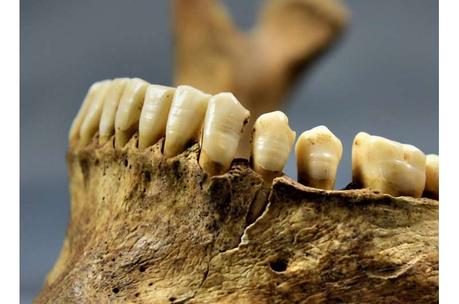
Visible deformities in tooth enamel that occur during tooth development and are considered identifiable physiological stress markers. Credit: Harbeck, SNSB - Staatssammlung für Anthropologie München
New research results show that some children in early medieval Bavaria were breastfed for much longer than today. Also, many early Bavarians buried around 500 AD are from other geographic regions where dietary practices apparently differed.
A team of researchers led by SNSB anthropologists Michaela Harbeck and Maren Velte analyzed human teeth from several archaeological sites in Bavaria. Their research results have been published in PLOS ONE And Archaeological and anthropological sciences.
A team of researchers led by anthropologist PD Dr. Michaela Harbeck, curator of the Bavarian State Collection for Anthropology in Munich, Germany (SNSB-SAM) and the LMU PhD candidate and project officer at the State Collection, Maren Velte, were able to provide information about the earliest life stages of adult humans from the early Middle Ages through through isotope analyzes of their teeth.
Harbeck and her colleagues analyzed human teeth from several medieval Bavarian cemeteries, mainly from the period around 500 AD. Teeth are formed during childhood and are characterized by little or no remodeling during life. This developmental quality makes them an ideal 'archive of childhood'.
Strontium isotopes provide an indication of a person's geographic origins, while analyzes of carbon and nitrogen provide information about diet. Serial isotope analysis shows the nutritional history from birth to about 20 years. This method reveals the transition process from feeding breast milk at an early age to ingesting solid foods during early childhood.
Complex migration processes
The origins of modern-day Europe date back to a period known as the Migration Period. During this time, dating between Late Antiquity and the Middle Ages, the Western Roman Empire came to an end and profound cultural and political changes began.
Many towns, villages and settlements have their origins in this period. In southern Bavaria, the Bavarian Duchy emerged in the sixth century from the former Roman province of Raetia secunda. The role that migration played in this process remains a matter of debate. Stable strontium isotopes from more than 150 early medieval human skeletal remains show that an above-average number of people of non-Bavarian descent migrated to the region of present-day southern Bavaria in the late 5th century. These trips involved both men and women.
"While we cannot determine the exact areas of origin of many individuals, we can show that they came from several non-local regions," said Harbeck, lead author of the study.
Certain dietary patterns atypical for Bavaria further suggest a foreign origin of some of the buried individuals. Several women shown to have genetic markers characteristic of southeastern Europe and who also exhibit artificially modified skulls consumed a diet consisting mainly of millet during their formative years. Millet cultivation is common in Eastern Europe and even Asia, but is currently rarely grown in Bavaria.
Harbeck states: "These women clearly grew up in other cultures outside of Bavaria. For some women we were even able to determine the approximate time of their dietary change, and therefore when they emigrated to Bavaria. For example, many of the women from southeastern Bavaria Europe did not immigrate as teenagers - as you would expect at the time in the context of marriage migration - but was already over twenty years old when they arrived in Bavaria.'
Weaning and complementary foods
In some subjects, detailed nutritional reconstruction was performed from birth to around age 10 years, including transition from breast milk to solid foods. These analyzes show that women in late antiquity and the early Middle Ages breastfed their children for much longer than today.
As Maren Velte says in her dissertation: "Withdrawal from breast milk was completed between the second and third year of life in most early Bavarian people studied. Women of foreign origin in particular were breastfed for significantly longer. Such long breastfeeding periods are known. of nomadic peoples, for example."
'Weaning stress'
The weaning process always involves some health risk for a baby. Children are suddenly and repeatedly exposed to new pathogens and possibly malnutrition. The resulting visible deformities in tooth enamel that occur during tooth development and are considered identifiable physiological stress markers can be interpreted to determine the age at which children were exposed to these stress events.
Babies raised in the period following the social upheavals in Bavaria apparently experienced particularly high levels of 'weaning stress'. In the 7th century, stress-related developmental changes in tooth morphology are particularly common.
The research team believes that fundamental changes in children's diets, especially with regard to complementary feeding, are to blame. Future research will reveal more details.
More information:
Maren Velte et al, Between Raetia Secunda and the Netherlands of Bavaria: research into patterns of human movement and nutrition, PLOS ONE (2023). DOI: 10.1371/journal.pone.0283243
Maren Velte et al., Tracing Early Life Histories from Roman Times to the Medieval Era: Weaning Practices and Physiological Stress, Archaeological and anthropological sciences (2023). DOI: 10.1007/s12520-023-01882-6
Offered by the Bavarian Natural History Collections
Quote: Childhood in Medieval Bavaria: What Teeth Reveal About Diet and Migration (2023, November 22) retrieved November 23, 2023 from https://phys.org/news/2023-11-childhood-medieval-bavaria-teeth-reveal.html
This document is copyrighted. Except for fair dealing purposes for the purpose of private study or research, no part may be reproduced without written permission. The content is provided for informational purposes only.
